- “The stones fall from the cliff during the night and I am sure we will all be covered by a landslide, but at least there is fresh water.”
- “… the island against which the poor ship came to grief.”
- Numbered objects are put into a steel wire basket and lifted with the hoist on the boat.
- For about three solid weeks we have done nothing but cut through marble with sledgehammer and chisels, trying to free the one lump that seems to preserve part of the hull
- Divers woke with water running under their cots and objects floating by
Just off Cape Gelidonya, on the southwest coast of Turkey, lies a row of five tiny islands, little more than rocky peaks on the sea and dots on a map. Sometime during the fourteenth or thirteenth century B.C. a small merchant ship tried to pass between two of these islands and, perhaps cracking against the jagged rocks during a stormy night, sank in ninety feet of water. As undisturbed as any ancient tomb or buried city, the ship lay, slowly disintegrating on the rocky bottom.
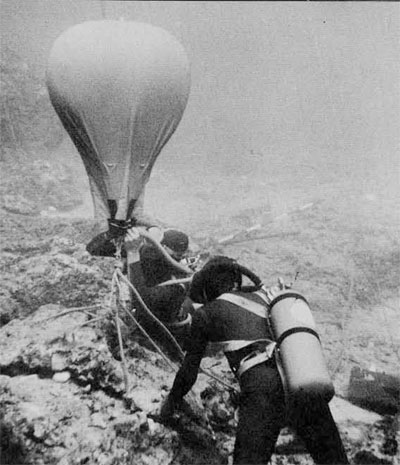

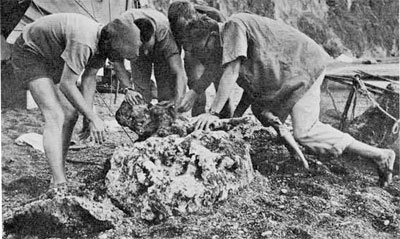
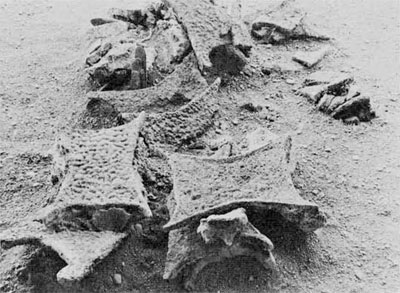
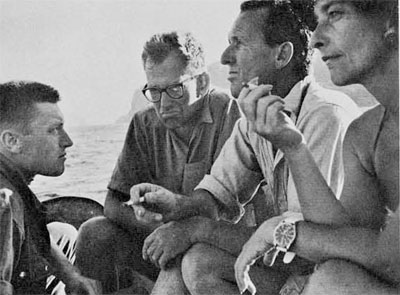
In 1958 Peter Throckmorton, a photojournalist from New York arrived in Bodrum, the sponge center of Turkey. Keenly interested in locating and charting ancient wrecks along the coast, he used his talents as a photographer and diver while working with the local sponge divers. For two summers he sailed on Mandalinci, a local sponge boat, questioning the captain, Kemal Arras, and other divers about what they had seen underwater. They showed him many wrecks and told him of many more. One of these was the ship off Gelidonya. By 1959 he had been able to dive on the wreck and recognized some of the objects on the sea-bed as being of the Late Bronze Age.
Realizing the importance of such a find he contacted the Council for Underwater Archaeology in San Francisco, which immediately inquired of the University Museum if it would be interested in organizing an expedition. Could there possibly have been any doubt! This would be the first scientific excavation to bring the precis methods of land archaeology to the bottom of the sea. And even more exciting, the excavation would be of by far the oldest shipwreck ever found. I was sent to the local YMCA to learn to dive.
Shortly thereafter Frederic Dumas, co-author of The Silent World, agreed to take leave from his post with the French Navy’s Underwater Research Group to be our chief diver, and Miss Joan du Plat Taylor joined us as the representative of the London Institute of Archaology, which handled the preservation of the finds. Other supporters were the Council for Underwater Archaeology, the Littauer Foundation, Mr. Nixon Griffis of New York, and the American Philosophical Society.
By April, I was in Istanbul with Mr. Throckmorton and Claude Duthuit, a French diver. A revolution was the least of our worries! How does one explain an eighteen-foot-long crate, containing parts for an air-lift and an underwater drafting frame, to a Customs official? Or a core-sampler for taking underwater soil samples? Or locate a misplaced recompression chamber? Or move a three-ton air-compressor from Ankara to roadless Cape Gelidonya?
Somehow most of these problems were solved and on June third we sent a cable to Dr. Rodney Young at the University Museum, saying that we had our permit and all equipment. Dr. Young may best recall our feelings and describe our work:
I came on to Finike with Miss Taylor and Miss Frost on the two boats, while Dumas and Peter and Hakki Bey came overland in the jeep (three days to our one and a half). We made final preparations in Finike and then had to wait for a few days because of bad weather. Finally we came out and spent half a day looking for a campsite. We found one about forty-five minutes to an hour away from the wreck on a NARROW beach that has cliffs on all sides and no way out. The stones fall from the cliff during the night and I am sure we will all be covered by a landslide, but at least there is fresh water. We dammed up a little trickle from the rocks and made quite a nice basin of fresh water for Miss Taylor to wash bronzed in. We are also making good use of a company tent, twenty-two mattresses, an electric generator, thirty pieces of canvas, etc., etc., (including two parachutes) that we conned out of the army. I will send a picture.
On the first day after we were here I stayed with Duthuit and Greer and helped organize the camp while Peter and Dumas went out to the wreck. They found it immediately. The next morning I went down to look at the wreck (ninety feet) with Dumas and Duthuit. Dumas also took Hakki Bey down, the first time that he had used an Aqua-lung. I have had no trouble with the diving and have been able to work underwater with the rest.
At first we were terribly disappointed as it appeared that some things had been removed and that there was little left:
But now the big news. This morning Miss Frost and Dumas went for a simple exploratory dive and returned with good news. He knocked off the corner of a large “platform” on which most of the loose stuff was lying and found that it was solid bronze to quite a way down. Then he moved into an area nearby, in a gulley, where we think we have the stone anchor, and found that again there is a tremendously thick deposit of bronze material, including whole ingots and tools and the like. He estimated it as at least a ton of material. So it looks like the Byzantine wreck must wait for another year, as we cannot get the things loose easily. Is this not the largest hoard of Bronze Age bronzes yet found?
However, we were only beginning. We experimented with photography:
Dumas got the idea of outlining the edges of important areas of the wreck with large white beach stones, which show up very well in photographs. Now, Peter and Duthuit are off making an underwater “aerial survey” of the area with ropes and meter sticks and levels and compasses. When they have enough pictures, we will be able to overlap them and make a good plan from which to label objects, etc. We have already lifted several ingots and a whole pot from the bottom, because they were scattered.
Three days later I was able to cable from Finike:
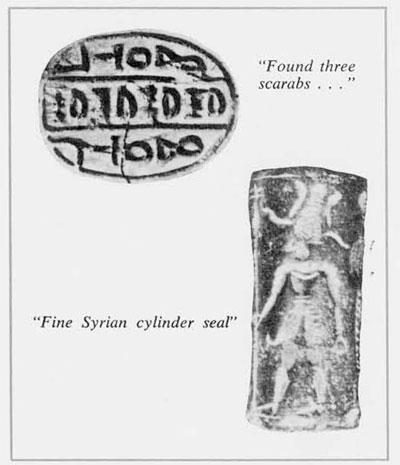
June 22, 1960
TONS CARGO HULL MAYBE SAILS PRESERVED SEVERAL YEARS JOB
My enthusiasm was explained in a letter written back at camp that night:
The interesting part is the wreck. We found timbers under one section, so hope to get part of the hull. The cloth that I thought might be sails turned out to be reed matting, and was probably a basket holding part of the cargo. There will be many more ingots and so far we have gotten several distinct types which have various marks on them. The tools are quite similar to the ones found last year, but there are new things, including a handful of bronze nails. Most of the wreck is so concentrated with sea deposits that we are going to try to raise large chunks of concretion with a boom on the ship and chip the pieces out on land. We now have a fairly good map of the area and are beginning to work in small areas at a time.
The diving itself is not too bad. It is rather tense work, however, and I think that people are less likely to be in a friendly mood after a dive. Our decompression chamber is still in customs and I, for one, do not enjoy the first hour after a long dive waiting to see if I shall come up with a case of bends. We are now making two dives a day when possible. We take lunch with us and either eat on the boat or row over to the island against which the poor ship came to grief.
The wreck seems to have been a junk ship, carrying a load of old metal objects. Although we are getting many different kinds of copper ingots and spear-points and agricultural tools, most of them seem to have been already broken when the ship was sailing (we do have quite a bit of evidence to prove that the things were not broken during the sinking of the ship). A great quantity of the cargo was just plain pieces of broken ingots. These pieces were either wrapped in baskets or, less likely, were lying on a woven mat over the deck.
The ship, itself, has been more-or-less outlined now by exploratory dives. Dumas and Duthuit then put white beach stones around the great mass of cargo, which seems to indicate the limits of the ship. The size of the ship and its cargo varies from day to day–underwater it is almost impossible to tell the difference between concreted cargo and stone without chipping it open–with Dumas’ present estimate being about a ton of bronze. A piece of well-preserved wood under the thickest mass of material (which has not been touched) has given us hopes that some of the hull will be well preserved. If it is, it will be in fine condition as pieces of twigs in the basket still preserve their bark.
We are now working in this manner. We have an overall plan of the area and also a photographic overlay of most of the area. We have labeled conspicuous objects which must be lifted and these are plotted on the plans. Then we go down with a draftsman and tie numbered plastic labels on the things I want lifted. These are then put into a steel-wire basket and lifted with the hoist. So far most of the lifting has been of loose ingots and objects. To get into the heart of the ship will be a different matter. We have tried loosening objects underwater and have made sets of chisels, crowbars, mason’s hammers and the like. But underwater there is simply not enough time and it is easier to break something than on land. Therefore we have decided to try to raise one piece all at once. To break it loose Dumas and Duthuit have been picking under the concretion, but it would take them months to loosen a very small section of just one area of the ship. Tomorrow, at Peter’s suggestion, they will try to use a car jack to break it loose.
If you see a large case, looking like the end of a torpedo, floating past your house, grab it. It’s our Polaroid camera. After all the troubles we’ve had getting it to France, having the case specially built, finding the lost film in Greece, etc., it was weighted perfectly so that it would stay at one level in the water. Today, the diver using it got water in his tubes and surfaced rapidly, leaving the Polaroid floating about eighty feet down. The current moved it away and even the sponge-divers joined in the search, but it is probably on its way to Italy by now.
A week later we got our first taste of worse things to come:
JUNE 29, 1960
If this letter reaches you in a bottle, fear for the worst. Our little beach is only about twenty feet wide and the south wind, which Kemal says never comes in summer, came today. We had wet feet eating supper, and if the waves rise the slightest bit more, we will be floating out here.
The work continues to be interesting. Today we got a jack under a large hunk of unintelligible concretion and cracked it loose. We then raised it with a cable and winch on the ship. After a bit of chiseling it turned out to be a stack of at least six, and maybe more, ingots of various shapes. Between two of these ingots a basket had been crushed, with rope and matting perfectly preserved. Under this platform is another pile of ingots, but between the two sections is a hollow dome which I wanted well drawn and photographed before moving more; it may contain the shape of the ship before some wood in this area rotted away. But it is too early to say.
Our food is now quite good. I will send a boat to Antalya every week if at all possible. I went the other day to get some medicine and take the compressor in for an overhaul and found out that they have every kind of fresh fruit and vegetables imaginable. Finike simply could not support us without a refrigerator. We lived on tomatoes and cucumbers for a week, with a little cheese, olives, and bread, and had meat and yogurt once. The only other protein we had was the fish that we could spear during the evening. The whole crew was getting pretty weak, for diving really takes it our of you, and I think that is why I came down with some bug. As a matter of fact, I am going to send the whole crew into Antalya this weekend for a day, for we have worked steadily for over two weeks without a single morning’s break. I think that a day off every two weeks would be a good thing, although most of us want to keep working every day now that we have so little time left and there is the very real fear that someone else will come and tear up the rest of the ship if we do not finish the job.
Most of us did go into Antalya for the weekend, but that was the last time. The next time we stopped working for a day was on September thirteenth, the day we broke camp and left the site. One of our headaches was mechanical:

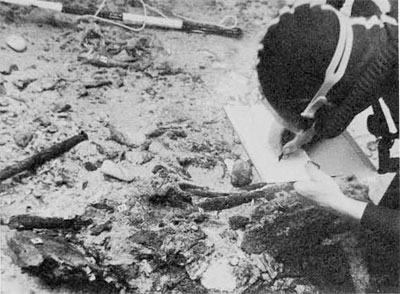
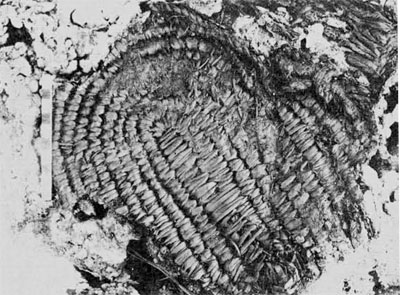
JULY 6, 1960
Compressor trouble is killing us. One still remains in customs, with Hakki Bey there now working to get it out. Our big compressor is still not working, but will fill the tanks enough for short dives. Peter’s old compressor is in Antalya at the mechanic’s. Luckily two Germans and an American arrived the other day and have asked to work with us for a week and they have a small compressor which is good for a few tanks a day, which is a help.
Yesterday I had Duthuit and Wlady, one of the German boys, chip loose a piece of concretion that had a wooden “handle” in it and the other side turned out to be filled with hundreds (if not thousands) of glass beads of various types, which are evidently part of the trading material. This shows that there is more stuff than just bronze and I am wondering if this was some of the stuff that was being traded for (or used to trade with).
JULY 7, 1960
We still have not got down to the wood which sticks our of the bottom of part of the cargo, but I am still assuming it is part of the hull. We have raised about half a ton of bronze and the greater part of the ship remains. I think that we can finish this season and we all feel that we must if we want it preserved. Some of the pikes have marks on them; many, if not most, of the ingots also have letters. We now have about sixteen ingots of various types, with more to come. Mixed in with every load we raise are pieces of sticks and twigs with the bark still on, so they were obviously not part of the hull. This had us all puzzled, but I started taking Homer out with me on the boat and some of us read through, looking for ship references. Peter found a description of a ship being built that mentions a grill of twigs being built around the deck to keep the heavy seas out.
The dreadful July current is truly bad. Today both of my fins were pulled off and I must now tie them on with rubber straps, but we must continue to work here. We MUST finish the job this year, for the local press has already come out with an article that the ship is full of gold and it is quite evident that even some of our sponge divers believe this to be true. Kemal says that a rich man from Izmir came to Bodrum and offered him a large sum of money to take him to the wreck.
In the afternoon there was little current, so we did a good job, but in the morning it was so strong that it was hard. I took Kemal down for the first time to show him what we were doing, so that he can have his men help us, and I had to swim upstream like mad every time I let go a rock and grab another to hold on. I even saw a fish being swept sideways until he could straighten around and face the current.
Traces of wood and woven material still were somewhat confusing:
JULY 14, 1960
Only a very short note to let you know that I was very discouraged when the wood we thought was hull turned out to be otherwise, but yesterday we uncovered much more of it and if it is not the planks of the ship I will eat my Aqua-lung. I stopped all diving today to give a chance to work on camera flash-attachments, air-lifts, drawings, etc., for the recording of the wood will be as difficult as it is important.
The air-lift was a large tube, which, working with air pumped from the surface, acted like a giant vacuum-cleaner. It was used for removing sand:
JULY 15, 1960
Rigged up air-lift today with Kemal’s compressor and it works like a feather duster. With it they found a small pocket of sand containing a set of small “apothecary’s weights” (one of lead), a “snake-headed” bracelet, a complete axe, and a whole chisel. All in nearly perfect condition. It seems that the sand layer under the crust may contain better preserved objects.
Near this pocket, Wlady Illing found our prize object to that time:
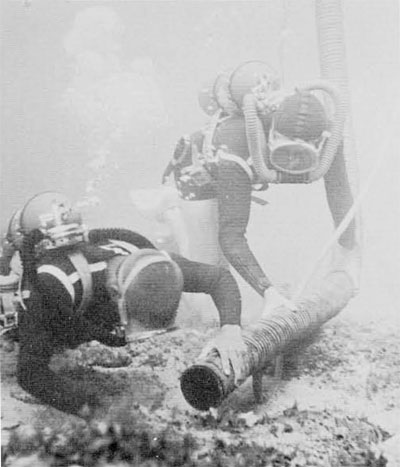
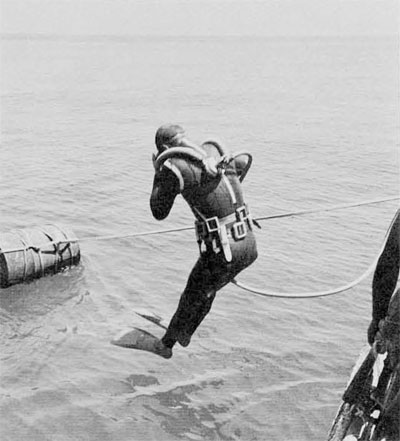
JULY 19, 1960
FINE SYRIAN CYLINDER SEAL
Shortly thereafter, all of our air-compressors died and we were no longer able to fill our Aqua-lungs. Peter rigged up two hoses to Mandalinci’s big compressor and we were able to dive in pairs with these, although in the strong current this was sometimes difficult. A twist in a hose could become a kink, cutting off all air at the bottom, and, more than once, two of us had to ascend sharing one mouthpiece and the air from one hose. Dangers were not confined to the bottom:
JULY 25, 1960
Left out one other bit of news. I was diving the day that the Seton Lloyds were on the boat (they came down from the British Institute in Ankara for a few days) and Duthuit suddenly appeared and called Dumas and Greer and me to the surface. Nazif, the captain of one of the boats, had caught his finger in a tight cable and cut part of his finger off (it was quite a rough sea while we were working). We started back to the camp and in the distance a fleet of sailboats appeared (a fairly rare sight). Kemal put our flag at half-mast and they returned the signal and sped toward us. It was a group of Bodrum sponge draggers on their way home, and they pulled in like the Sixth Fleet, towed our boat (they are faster) back to camp and we put medicines in and on Nazif and sent him back to Finike with them. Today I saw his finger and he will be able to come back to work now, not losing very much of it. Miss Taylor and Peter had acted very quickly before I got up and had bandaged the wound and stopped the bleeding.
Findings became increasingly exciting:
JULY 30, 1960
Found three scarabs (two faience, one ivory) with hieroglyphic inscriptions, and a polished stone mace-head. Peter spotted them all. The job is running very slowly now as we are trying to get all evidence from the preserved ribs and planks of the ship; the planks show dowel holes. Ryan and Egdemir are drawing these on the bottom. Am quite pleased with the way things are going on the dig. Have about two hundred numbered objects nos, including a bronze spade I hadn’t mentioned. It looks now as if we are entering the “captain’s cabin” with mace-head, scarabs, many more weights; I expect more.
And:
AUGUST 8, 1960
PLANKS, RIBS, FOURTH SCARAB, MACE-HEAD, CRYSTAL
The “captain’s cabin” looked increasingly like living quarters. Along with another scarab, more crystal, and another mace-head, there appeared the only lamp found on the wreck, and evidence of the crew’s food–fish, bones, olive pits, and a knucklebone from a sheep or goat–concreted under some bronze. Also in this area was a large pile of what may have been firewood: chopped sticks with bark and twigs still attached.
With the increase in finds came a decrease in letters. We were just too busy:
AUGUST 26, 1960
WORK UNFINISHED CABLE IF TWO THREE WEEK LATER TICKET CHANGE POSSIBLE OTHERWISE RETURNING NOW
SEPTEMBER 4, 1960
By now you must have received my cable asking for a delay in my return, and you must wonder why, since there is no news from this end. The reason that there is no news is that for about three solid weeks we have done nothing but cut through marble with sledge-hammer and chisels, trying to free the one lump that seems to preserve part of the hull…We dive two at a time, twice a day–the first dive for forty minutes and the second for twenty-five (Lufti Bey times us and signals when to come up by banging two pieces of metal together just under the surface). The hull is just about ready to come up and that is the reason I wished to stay.
Otherwise, we are terribly tired, never take a day off from diving, the weather is getting colder, part of our cliff came down on the tent the other evening, two of the divers saw a shark, Ann nearly drowned with a faulty regulator and leaking face mask and refuses to dive again (ever!), the current has been fantastic, rice and beans are getting tiresome, the compressor broke again and we have been diving with narghile (hose to surface), and if we have an earthquake or a blizzard I won’t be surprised.
A few days later, Nixon Griffis, a recent arrival, Peter and I broke loose the stubborn “hull lump,” and raised it to the surface. It was time that the job was finished; machines and divers were wearing down. All that remained of our work was to search the sand for hidden deposits of metal. Just at that time, Luis Marden, of the National Geographic, paid us a short visit. We were in luck. But I didn’t even remember to date my last, short letter.
FINIKE POST OFFICE
Marden’s underwater metal-detector found new bronze–excellent gadget…Also, white powder identified by Turyag labs as tin oxide from TIN as I suspected. The captain was making his own bronze as he went with the copper ingiots.
The new pieces of bronze were quickly raised. Our job was ober. The fall winds had twice sent the waves crashing into our camp. Divers woke with water running under their cots and objects floating by. It was time to leave. With Duthuit giving penicillin shots under a black sky, we loaded our camp onto the boats and left our beach. I wonder if the others are as homesick for that spot as I am no and are eager as I am to go back this summer?





